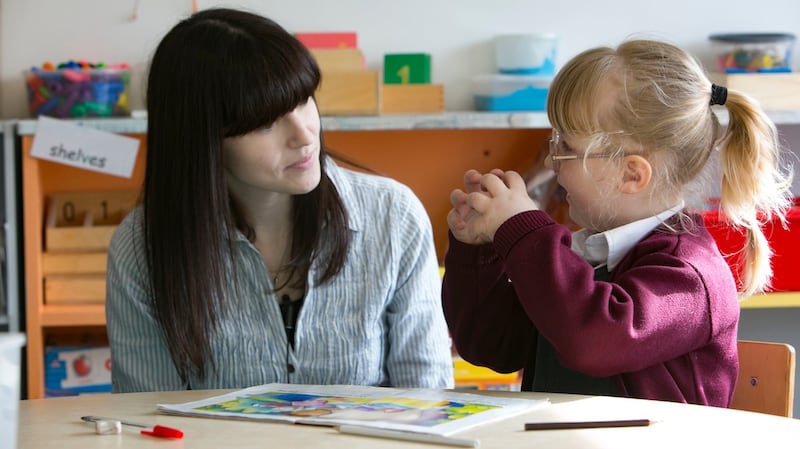Soon after Calum Geary was born, doctors realised there was a problem: he didn’t have the vital auditory nerves that transmit sound information from his middle ear to his brain.
It made him one of a handful of deaf children in Ireland who cannot benefit from any kind of hearing aid technology.
“We knew there were a multitude of barriers in front of Calum,” said his father, Andrew. “We knew he was a bright boy and as a family we needed to knock down the barriers between him and his potential.”


So the family switched their focus squarely to learning Irish Sign Language (ISL).
ISL, like other sign languages such as British Sign Language or American Sign Language, has its own complex linguistic structure, grammar, rules and features. It can take years to reach anything approaching full fluency in any of the languages.
When he reached school age, Calum’s parents decided to send him to St Columba’s National School in Douglas, Cork – about 80km from their home in Ballyhooley – because it had a facility for deaf children.
By the time he reached first class, it became clear that Calum was falling well behind his twin brother, Donnacha.
“It broke my heart that Calum couldn’t pick up a book the same as his three brothers,” says Andrew.
The reality began to dawn that, although they were very happy with Calum’s teachers and had learned some sign language, he was in danger of never reaching his full potential.
That realisation came when Geary read Raising and Educating a Deaf Child, a book by Dr Marc Marschark, a US professor and adviser to Irish education authorities.
It espouses the theory that to acquire any language – whether signed or spoken – children must have exposure to the highest quality and quantity of language input “via meaningful interactions with others who are already capable users of the language”.
Andrew recalls: “When I read it, it just blew me away. But it also gave him a sinking feeling. “I should have known this, but no-one had ever told me about it.”
It is almost 20 years since the Education Act recognised the right of deaf children for the first time to receive an education using Irish Sign Language.
It was hailed at the time as a major breakthrough: it would pave the way for members of the Deaf community to participate as full citizens of their own country.
But an Irish Times investigation shows this has not been backed up by a comprehensive effort to ensure teachers of the deaf – many of who trained during an era in when sign language was banned from education – are trained to a satisfactory level.
As a result, it is the only language that a teacher does not need any formal qualification in order to teach.
It also raises wider questions over whether many of the dozens of sign-dependent deaf children in our classrooms are failing to reach their potential due to lack of access to teachers with specialist training.
This is despite official policies which state that deaf or hard-of-hearing children should be able to leave school with levels of educational attainment on a par with other children.
Calum’s father was growing increasingly worried about his son’s progress at school.
While the National Council for Special Education (NCSE) has recommended that teachers in specialist settings should have a “minimum standard of competence in the use and teaching of ISL”, Andrew felt this was not being implemented.
“If I’m going to teach French, German, Italian, any other language, I have to have a level eight degree,” he says.
“If Calum is to reach his academic potential, he needs someone that’s at one with Irish Sign Language. Luckily enough, there were people in the Department of Education who understood that.”
He put together a detailed application and lobbied politicians to fund a qualified sign language interpreter in Calum’s classroom. After several weeks, a letter came in the post confirming the grant.
Calum’s parents are not the first to seek to force the State to fulfil its obligations to provide an education through fluent ISL.
During the mid to late 2000s, a number of parents took the department to the High Court.
These cases were settled and parents say they were not allowed to discuss their case publicly.
While the department funds younger teachers of the deaf to acquire specialist qualifications at a number of UK universities by distance learning and occasional trips to the campuses, these courses do not contain any ISL tuition.
In response to queries, the department said “special schools for the deaf have been encouraged in relation to the use of sign language in class”, but between 2012-2016 only five teachers from these schools availed of funding to improve their ISL.
Dr John Conama, at Trinity's Centre for Deaf Studies, believes a key problem is that ISL is regarded in assessments as a compensatory tool rather than a language in its own right. "Hence the decision to allow access to ISL is often arbitrary," he says.
This, he says, is a hangover from the days when “oralism” was the main approach: students were taught exclusively through listening and speaking and with the help of audio technology, and without any sign language.
Evidence in Ireland and elsewhere has since proven the failure of that approach, which was only abandoned here in the early 1990s.
Historians have noted with some irony evidence that those educated before the 1950s – when oralism was introduced – tended to have far better standards of literacy.
These days, there is a much greater recognition that ISL helps deaf people flourish in the community, though this is not always reflected on the ground, say campaigners.
“ISL is not celebrated, it’s just tolerated. But ISL is for everyone. ISL is enjoyable and can benefit every one of us,” Dr Conama says.
Calum, now eight years of age, has benefited hugely from having an educational interpreter in his class since last year, say his parents.
“Even his spelling has improved a lot. Before, it was totally rote learning, whereas now he’s taking a more active role,” says Andrew. “He’s getting out a book and he’s starting to read it, whereas before he wouldn’t – he would be afraid of it. And he has a great teacher, they’re a great team,” he adds.
His mother Helen also says other deaf children in the class, who have hearing aids, cochlear implants and other technologies, are signing more.
“He’s able to play more and interact more with the children in the playground,” she says.
They are worried, however, that his access to a interpreter is not guaranteed.
“Calum will have his interpreter for up to four years,” says Andrew Geary. “What’s going to happen in 2020?”
Home life, meanwhile, is firmly bi-lingual. While Calum’s mother’s signing today is competent, Andrew has struggled because shift work as a Garda sergeant prevented him from attending as many classes as he would like. His transfer to a new role should allow him more time to improve.
“The siblings are very deaf-aware obviously,” says Geary.
“They don’t see Calum as a disabled brother. They see him as a brother who has a different language. That’s the way they look at him. And they give out to us if we treat him any different.”
[ Mary Raftery Journalism FundOpens in new window ]
Irish sign language: in numbers
5,000 – Irish Sign Language is the first (or preferred) language of about 5,000 people in Ireland 40,000 – Estimated number of people who use Irish Sign Language daily, including the deaf community and their family, friends
3,300 – Estimated number of deaf children who are mainstream-educated
4% – Estimated proportion of deaf children in mainstream-education who are using sign language
How one school is working to improve sign language tuition: The Midwest School for the Deaf in Limerick is pioneering a number of projects to help improve ISL tuition.
“Our ethos is open and welcoming for all deaf children, whether they have a mild hearing loss and are oral students, or if they are profoundly deaf students who use sign language,” says principal Maria Allen. “We respect the rights of the parents, and its up to them what language they use.”
It is currently engaged in two projects that it hopes will have a lasting impact on deaf education in Ireland.
The first is a curriculum for Irish Sign Language (ISL) based on the Irish curriculum, which was suggested by the school’s inspector, Johnny Murphy. The school employed a teacher, Rory Kiff, who helped to further develop it.
“What we did was we took the Gaeilge curriculum and translated it into English, and onto that we mapped the vocabulary that should be achievable at different levels into sign language.”
The document, which includes visual aids for each word, and online videos in ISL, is now called Functional Language Communication Aid.
“It’s being used by the Special Education Support Service now, not just for ISL, but all language and communication for children with special needs.”
The second project is a trial of an ISL curriculum for Junior Cert with a local secondary school, as well as at Midwest. The tutor is John Patrick Doherty, who trained at the Trinity College Centre for Deaf Studies.
“They love it,” Allen says of the Midwest students who are doing the course. “We use sign language every day to communicate but this is a very structured curriculum.”
However, she fully appreciates the limits of what they can do, whether it’s because of their very limited budget as a small school or the inherent flaws in the deaf education system when it comes to the teaching of Irish Sign Language.
“We would love to have a qualified interpreter working in the school, and I think it’s something that we should have access to.
“It costs the board of management a lot of money any time we need an interpreter in the school. Obviously, we can do a lot ourselves, but there are occasions when you need an interpreter, and that is a financial burden that is placed on the board of management to cover.”
They are also not in a position yet to provide a bilingual education through ISL because of the teachers’ current proficiency levels.
Technically, the method they use is called “total communication”, where the teachers sign and speak at the same time. However, the school has four SNAs who are deaf and fluent ISL users who provide a critical bridge for the children who use sign as their first language.
“If I’m trying to explain something, even though I’m signing it, when one of the deaf SNAs works on that and explains it through pure ISL, the children understand it, they grasp it so much faster,” she says.
“Even though we would say we would have a good level of sign language, I would be very competent, but still when you have somebody who has pure ISL working with them, it makes such a difference. It makes our jobs much easier as teachers because it isn’t taking as long to explain something.
“And then I can go back and map that onto English, where I say this is the grammar, this is the structure, etc. For example, if you were teaching them something about geography and about river erosion, they have the concept in ISL, now they can put English to it.”













